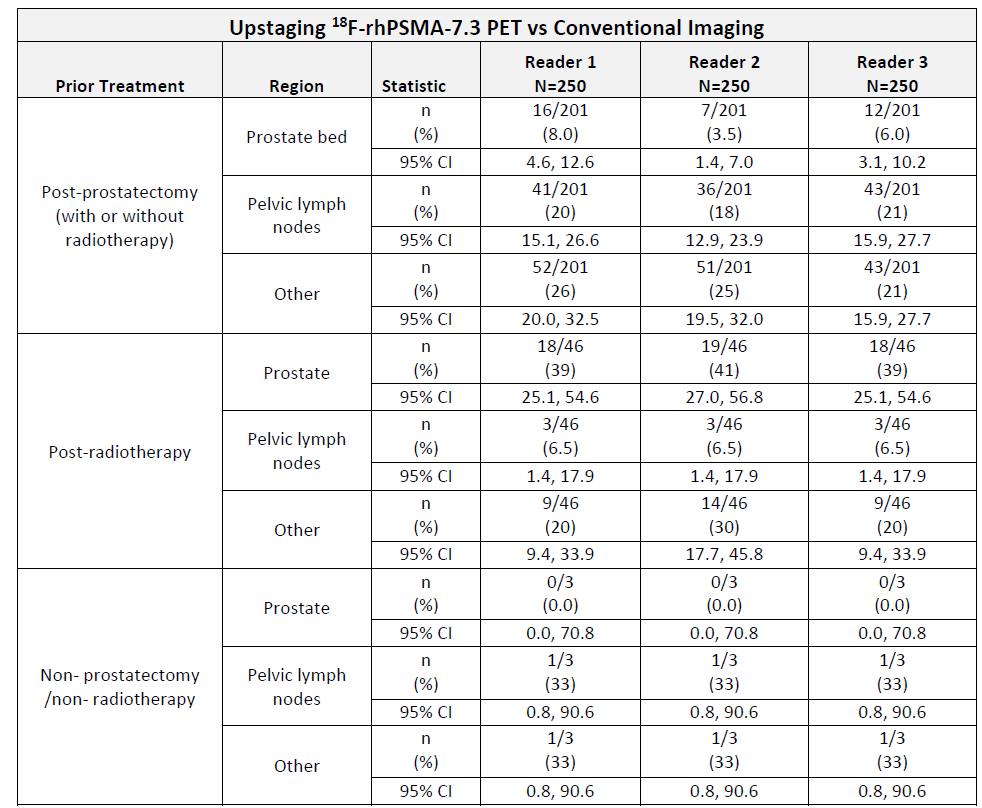Back
Plenary
Plenary: Friday Morning
PLLBA-02: Impact of 18F-rhPSMA-7.3 PET on upstaging of patients with prostate cancer recurrence: Results from the prospective, phase 3, multicenter, SPOTLIGHT study
Friday, May 13, 2022
11:13 AM – 11:21 AM
Location: Great Hall A
Mark Fleming*, Norfolk, VA
- MF
Presenter(s)
Introduction: Accurate localization of biochemical recurrence (BCR) of prostate cancer can inform optimal salvage therapy. 18F-rhPSMA-7.3 represents a new class of high affinity prostate-specific membrane antigen-targeted positron emission tomography (PET) radiopharmaceuticals with potential for low bladder activity.
SPOTLIGHT (NCT04186845) assessed the diagnostic efficacy of 18F-rhPSMA-7.3 in men with BCR. Here, we report the impact of 18F-rhPSMA-7.3 on patient upstaging compared with conventional imaging.
Methods: Men with suspected BCR underwent PET 50–70 min after IV administration of 296 MBq 18F-rhPSMA-7.3. PET results were validated using histopathology and/or conventional imaging as a composite Standard of Truth (SoT). Image guided biopsies of PET lesions took place =60 days post-PET and confirmatory imaging took place =90 days. Three blinded central readers evaluated the 18F-rhPSMA-7.3 PET scans.
The number of positive 18F-rhPSMA-7.3 scans in defined regions that led to upstaging of the patient was documented for patients with negative baseline conventional imaging (performed =118 days before PET) and the results were stratified according to the patients’ prior therapy.
Results: In total, 366 men (mean [range] PSA 3.95 [0.03–134.60] ng/mL) were enrolled across 27 US/European sites, underwent 18F-rhPSMA-7.3 PET, and had sufficient data to determine a SoT. Overall, 57% of these men had =1 true positive lesion.
The table shows variation by prior treatment, region and reader upstaging vs conventional imaging. Among patients who had undergone prostatectomy 3.5-8.0% of 18F-rhPSMA-7.3 positive scans showed lesions in the prostate bed region, with 18-21% in pelvic lymph nodes and 21-26% in other sites that led to upstaging vs conventional imaging. Among those who had received radiotherapy, these values were 39-41%, 6.5% and 20-30%, respectively. Very few patients had an alternative primary therapy; thus, no definitive conclusions could be drawn for them.
Conclusions: 18F-rhPSMA-7.3 PET findings frequently resulted in post-scan upstaging compared with conventional imaging, particularly among patients with intact prostates. The use of 18F-rhPSMA-7.3 PET may help to better define sites of disease recurrence and inform salvage therapy decisions.
Source of Funding: Blue Earth Diagnostics Ltd

SPOTLIGHT (NCT04186845) assessed the diagnostic efficacy of 18F-rhPSMA-7.3 in men with BCR. Here, we report the impact of 18F-rhPSMA-7.3 on patient upstaging compared with conventional imaging.
Methods: Men with suspected BCR underwent PET 50–70 min after IV administration of 296 MBq 18F-rhPSMA-7.3. PET results were validated using histopathology and/or conventional imaging as a composite Standard of Truth (SoT). Image guided biopsies of PET lesions took place =60 days post-PET and confirmatory imaging took place =90 days. Three blinded central readers evaluated the 18F-rhPSMA-7.3 PET scans.
The number of positive 18F-rhPSMA-7.3 scans in defined regions that led to upstaging of the patient was documented for patients with negative baseline conventional imaging (performed =118 days before PET) and the results were stratified according to the patients’ prior therapy.
Results: In total, 366 men (mean [range] PSA 3.95 [0.03–134.60] ng/mL) were enrolled across 27 US/European sites, underwent 18F-rhPSMA-7.3 PET, and had sufficient data to determine a SoT. Overall, 57% of these men had =1 true positive lesion.
The table shows variation by prior treatment, region and reader upstaging vs conventional imaging. Among patients who had undergone prostatectomy 3.5-8.0% of 18F-rhPSMA-7.3 positive scans showed lesions in the prostate bed region, with 18-21% in pelvic lymph nodes and 21-26% in other sites that led to upstaging vs conventional imaging. Among those who had received radiotherapy, these values were 39-41%, 6.5% and 20-30%, respectively. Very few patients had an alternative primary therapy; thus, no definitive conclusions could be drawn for them.
Conclusions: 18F-rhPSMA-7.3 PET findings frequently resulted in post-scan upstaging compared with conventional imaging, particularly among patients with intact prostates. The use of 18F-rhPSMA-7.3 PET may help to better define sites of disease recurrence and inform salvage therapy decisions.
Source of Funding: Blue Earth Diagnostics Ltd


.jpg)
.jpg)